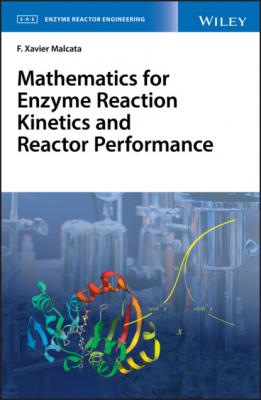Mathematics for Enzyme Reaction Kinetics and Reactor Performance. F. Xavier Malcata
Читать онлайн.| Название | Mathematics for Enzyme Reaction Kinetics and Reactor Performance |
|---|---|
| Автор произведения | F. Xavier Malcata |
| Жанр | Химия |
| Серия | |
| Издательство | Химия |
| Год выпуска | 0 |
| isbn | 9781119490333 |
by virtue of Eq. (4.47) – complemented by the nil product of zero by any scalar and the nil sum of resulting zeros; Eq. (4.69) is an alias of
meaning that premultiplication by a null matrix leads necessarily to the corresponding null matrix as product – where the latter has number of columns not necessarily coincident with that of the factor null matrix.
A final property of interest pertains to simultaneous performance of addition and multiplication of matrices, viz.
upon retrieval of Eqs. (4.2), (4.3), and (4.50) with p ≡ n; in view of Eq. (4.4), it becomes possible to redo Eq. (4.71) to
(4.72)
whereas application of Eq. (4.47) allows further transformation to
In view of the distributive property of multiplication of scalars, Eq. (4.73) turns to
(4.74)
where splitting of the summation meanwhile took place – with the aid of the associative property of addition of scalars; the algorithm labeled as Eq. (4.47) may again be retrieved, viz.
(4.75)
along with Eq. (4.4) – which is the same to say
again at the expense of Eqs. (4.2), (4.3), and (4.50). By the same token,
– in view of the definitions of A, B, and C, via their generic elements conveyed by Eqs. (4.2), (4.46), and (4.50) with p ≡ n; Eq. (4.4) supports transformation of Eq. (4.77) to
(4.78)
while Eq. (4.47) permits conversion to
Based on the distributive property of multiplication of scalars, Eq. (4.79) will give rise to
(4.80)
together with replacement of the summation of the sum by the sum of corresponding summations; Eqs. (4.4) and (4.47) may finally be called upon to write
(4.81)
or else
again due to Eqs. (4.2), (4.46), and (4.50). Therefore, both the pre‐ and the postmultiplication of matrices are distributive.
In the case of an (n × n) matrix, one may proceed to sequential multiplication k times by itself – usually labeled as
(4.83)
the outcome is still an (n × n) square matrix – while
(4.84)
is usually set by convention. In view of the unique features of an identity matrix outlined in Eqs. (4.61) and (4.64), one realizes that
(4.85)
– because multiplying an (n × n) identity matrix by itself leaves any of them unchanged.
If two matrices are partitioned in blocks, multiplication is still to follow the algorithm conveyed by Eq. (4.47) – as long as elements are replaced by germane submatrices; however, the underlying rules of compatibility between columns and rows of factor blocks are to be satisfied by all products. Consider, in this regard, the most common (and simplest) case of a (2 × 2) block matrix, viz.
